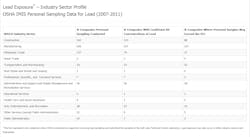Cancer Vessel: Inspectors Find High Lead Levels at Fraser Shipyards
When it comes to harmful substance exposure, workers pay the ultimate price: their life. OSHA estimates more than 800,000 workers in general industry and another 800,000 in construction are exposed to lead.
Recently, sampling results from a Fraser Shipyards worksite demonstrated the seriousness of lead and harmful substance exposure to the workforce.
Federal health inspectors found the Superior, Wis. company, which repairs and performs maintenance on vessels in the Great Lakes region, exposed 14 workers to 20 times the lead exposure limit and other heavy metals during the retrofitting of a ship's engine room, a $10 million contract job secured through Interlake Steamship Company of Middleburg Heights, Ohio.
Multiple complaints about unsafe working conditions spurred the February 2016 health inspection, resulting in a proposed $1.4 million in citations.
"Fraser Shipyards accepted a contract with a very low profit margin and penalties for delayed completion, but could not meet the schedule without endangering its workers,” said Dr. David Michaels, OSHA assistant secretary of labor in a statement. "When companies prioritize profits and deadlines over the health and safety of their workforce, it is the workers who pay the price. Law-breaking employers must be held accountable for their unlawful behavior. "
OSHA determined the company management knew of the presence of lead, asbestos, iron oxide, arsenic, hexavalent chromium and cadmium throughout the vessel. Overexposure to lead can lead to brain damage, as well as gastrointestinal effects, anemia and kidney disease. Exposure to asbestos increases the risk of lung cancer and mesothelioma, a cancer of the lining of the lungs and abdomen.
More than 75 percent of an additional 120 employees tested showed elevated blood lead levels, and none of those employees were required to take medical evaluations or exposure monitoring according to the agency.
While Fraser does have a written asbestos compliance program, employees were not informed of the cancerous fiber’s presence not given the proper respiratory protection or other PPE to protect workers.
The company has responded in a written statement regarding the steps it is taking to address the OSHA violations.
“We take the health and safety of our people and our community seriously. We acted to protect our people as soon as we learned of the problems,” said James Farkas, president and chief operating officer of Fraser Industries, which oversees Fraser Shipyards. “We have worked with all of our employees, laborers and contractors to ensure their health by bringing in medical experts as well as the highest levels of testing, protective equipment and safe operating procedures. We strongly disagree with OSHA’s statement that any of the issues were caused or worsened by business or profit motivations.”
The company claims it halted work as soon as it was alerted to high lead levels and other concerns on the project and purchased PPE including protective suits, respiratory equipment and cleaning supplies.
In addition, Fraser has engaged medical professionals, OSHA and union officials representing workers to develop and implement extensive new safety procedures, including protections for how employees, laborers and contractors prepare for work, conduct work and clean up after work, according to the company.
“We appreciate their responsiveness to getting this issue fixed and taking care of our members,” said Mark Garrett, Director of Health and Safety Services for the International Brotherhood of Boilermakers in a statement. “We don’t get many employers that step up like they did. They were straightforward, asked for our help and put in place our recommendations for safety.”
Despite Fraser’s actions to address the situation, this is not the company’s first experience with hazardous material violations. OSHA cited the shipyards for exposing workers to asbestos hazards in 2000 and for multiple lead violations in 1993. In fact, since 1972, the agency has inspected Fraser 28 times for similar allegations.
The company plans to work with OSHA on a settlement to reduce its fines. However, a decrease is something that will work against protecting workers in the future, says J. Brent Kynoch, managing director, Environmental Information Association.
“Hopefully, OSHA will stand firm on the almost $1.4 million in fines, rather than reducing the fines through negotiation,” Kynoch said in a statement. “It is only with firm enforcement of the nation's regulations that employers will work harder to ensure the safety of their workers. Employers must be held to a high standard in protecting workers from exposure.”
United States regulatory bodies should work harder on a final ban on asbestos and hazardous materials still allowed in commerce, he concluded.
